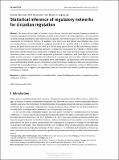Files in this item
Statistical inference of regulatory networks for circadian regulation
Item metadata
| dc.contributor.author | Aderhold, Andrej | |
| dc.contributor.author | Husmeier, Dirk | |
| dc.contributor.author | Grzegorczyk, Marco | |
| dc.date.accessioned | 2015-05-31T23:10:59Z | |
| dc.date.available | 2015-05-31T23:10:59Z | |
| dc.date.issued | 2014-06 | |
| dc.identifier | 132234515 | |
| dc.identifier | 3a8f7e70-625e-4d32-9ef8-0fac74099abc | |
| dc.identifier | 000337155900001 | |
| dc.identifier | 84902486319 | |
| dc.identifier | 000337155900001 | |
| dc.identifier.citation | Aderhold , A , Husmeier , D & Grzegorczyk , M 2014 , ' Statistical inference of regulatory networks for circadian regulation ' , Statistical Applications in Genetics and Molecular Biology , vol. 13 , no. 3 , pp. 227-273 . https://doi.org/10.1515/sagmb-2013-0051 | en |
| dc.identifier.issn | 2194-6302 | |
| dc.identifier.uri | https://hdl.handle.net/10023/6717 | |
| dc.description | The work described in the present article is part of the TiMet project on linking the circadian clock to metabolism in plants. TiMet is a collaborative project (Grant Agreement 245143) funded by the European Commission FP7, in response to call FP7-KBBE-2009-3. Parts of the work were done while M.G. was supported by the German Research Foundation (DFG), research grant GR3853/1-1. A.A. is supported by the BBSRC and the TiMet project. | en |
| dc.description.abstract | We assess the accuracy of various state-of-the-art statistics and machine learning methods for reconstructing gene and protein regulatory networks in the context of circadian regulation. Our study draws on the increasing availability of gene expression and protein concentration time series for key circadian clock components in Arabidopsis thaliana. In addition, gene expression and protein concentration time series are simulated from a recently published regulatory network of the circadian clock in A. thaliana, in which protein and gene interactions are described by a Markov jump process based on Michaelis-Menten kinetics. We closely follow recent experimental protocols, including the entrainment of seedlings to different light-dark cycles and the knock-out of various key regulatory genes. Our study provides relative network reconstruction accuracy scores for a critical comparative performance evaluation, and sheds light on a series of highly relevant questions: it quantifies the influence of systematically missing values related to unknown protein concentrations and mRNA transcription rates, it investigates the dependence of the performance on the network topology and the degree of recurrency, it provides deeper insight into when and why non-linear methods fail to outperform linear ones, it offers improved guidelines on parameter settings in different inference procedures, and it suggests new hypotheses about the structure of the central circadian gene regulatory network in A. thaliana. | |
| dc.format.extent | 47 | |
| dc.format.extent | 6782069 | |
| dc.language.iso | eng | |
| dc.relation.ispartof | Statistical Applications in Genetics and Molecular Biology | en |
| dc.subject | Regulatory network inference | en |
| dc.subject | Circadian clock | en |
| dc.subject | Hierarchical Bayesian models | en |
| dc.subject | Comparative method evaluation | en |
| dc.subject | ANOVA | en |
| dc.subject | Bayesian networks | en |
| dc.subject | Biological-systems | en |
| dc.subject | Variable selection | en |
| dc.subject | Expression data | en |
| dc.subject | Models | en |
| dc.subject | Clock | en |
| dc.subject | Regularization | en |
| dc.subject | Specificity | en |
| dc.subject | Lasso | en |
| dc.subject | QH301 Biology | en |
| dc.subject | QA Mathematics | en |
| dc.subject.lcc | QH301 | en |
| dc.subject.lcc | QA | en |
| dc.title | Statistical inference of regulatory networks for circadian regulation | en |
| dc.type | Journal article | en |
| dc.contributor.institution | University of St Andrews. School of Biology | en |
| dc.identifier.doi | 10.1515/sagmb-2013-0051 | |
| dc.description.status | Peer reviewed | en |
| dc.date.embargoedUntil | 2015-06-01 |
This item appears in the following Collection(s)
Items in the St Andrews Research Repository are protected by copyright, with all rights reserved, unless otherwise indicated.

